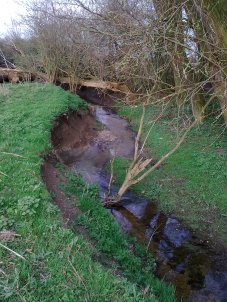December 31st, 2010. Misty, mild, damp and dull. A dismal winter’s afternoon for a final walk. I go north. On the edge of the village starlings whistle from treetops. Collared doves fan their pale wings and croon. A heron lifts off from a garden gnome-pond, majestic against the paltry, painted statuary. Each time I look up, lines of gulls furrow the cast of grey high above – all flying northwest, as they do at this hour each and every day. Still they come. Far out in the foggy fields, gunshots empty the afternoon. There are few creatures about. The way is muddy, black with sodden leaves. No snow remains, and only the deepest ruts still hold ice. From a hidden coppice an eruption of jackdaws crackles like fireworks and subsides just as suddenly. The Detention Centre lies desolate behind barbed wire and playing fields, closed down, the seekers of succour sent elsewhere or back home, where they least want to be. A graveyard of dreams. No more the sound of Iraqi, Kurdish, Afghan and Somali tears and laughter here. Mute wood pigeons roost in leafless trees like strange grey fruit. The hedgerows too are silent.
I reach the guided-busway, busless still, two slick concrete tracks curving off into the dimming afternoon, a swathe of folly through the countryside. Somewhere far off, a pheasant hiccups into life then winds down, answered by others across the track. On my right, the old airfield, fenced and forbidden. No Northstowe new town yet, thank God, a brief reprise – there is perhaps one more skylark spring to come. The flashing orange light of a security truck creeps past in the gloom, defending the ill-gotten gains of the land-grabbers. On my left, from the curl of the stream beyond, an excitement of ducks breaks the silence of the fast-falling dusk. First one, then two, three and four parties of mallard, five to nine in each band, fly west, overhead, dark duck shapes pinned against the sky. Spring’s last wild brood.
A year has passed since I first set out on this journey round the village fields. A year to discover what was here, and what was not. We’ve come full circle now, the seasons and I, back to the beginning, where we started. “And the end of all our exploring will be to arrive at where we started and know the place for the first time”. Knowing nothing when I first set out, I had few expectations, and I can say that now I know a little for the first time. I had prayed for some special encounter, some final revelation, some hope to end the journey but this has been one of the emptiest, most uneventful walks of the year. It is as it should be, for I do not want to give the impression of a place brimming with beauty and light and life, although, at times, it did briefly seem so. This poor patch of England, let’s face it, is an undone place, impoverished, bereft of almost all that is wild and worthy and free. The natural has for the most part been emasculated, suppressed or banished altogether. It has been replaced by the bland and unbeautiful, an ersatz and infertile reality. Only fleet remnants remain, caught out of the corner of the eye, when least expected. It breaks through, despite the weight of arrogance and ignorance and greed. It will abide. But for now, it is a flight of ducks against a darkling sky. That’s all.





